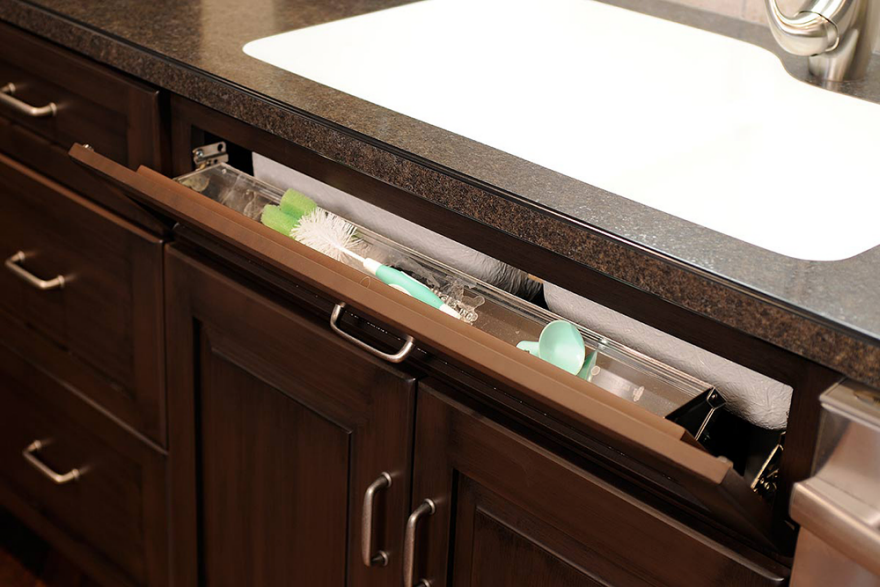
Space-Efficient Storage: Tip-Out Designs
Make shallow space useful with specialty or DIY hinges
When it comes to storage we tend to think in terms of cabinets, cubbies, drawers or shelves. Those form factors are all predicated on having enough depth to be useful. But as we try to squeeze every last useful cubic inch out of our homes, we can use tip-out form factors to gain storage from shallow, otherwise unusable spaces.
A prime example of this is in front of sinks, which are often faced with false drawer fronts. These seemingly scant inches of dead space can be filled with smaller items, whether in the kitchen or bathroom.
 Enter a caption (optional)
Enter a caption (optional) Enter a caption (optional)
Enter a caption (optional) Enter a caption (optional)
Enter a caption (optional) Enter a caption (optional)
Enter a caption (optional) Enter a caption (optional)
Enter a caption (optional)Your average bathtub is surrounded by a lot of potentially-useful dead space.
 Enter a caption (optional)
Enter a caption (optional)The one downside to using tip-out storage in kitchens and bathrooms is moisture. Were I to install those I'd use them for dry items rather than put-away-wet items; without air flow, I'd think moist items in an enclosed space would be a recipe for mold.
 Enter a caption (optional)
Enter a caption (optional)For frequent cooks with families, there are tip-out storage units for bulk food storage:
 By Wood-Mode, Inc.
By Wood-Mode, Inc. Shoe storage is another good application for the tip-out form factor.
 Enter a caption (optional)
Enter a caption (optional)Unless you're storing boots, it's a good way to fit a lot of footwear in much less space than they'd take up horizontally. In particular, look at how shallow these white cabinets are.
 Enter a caption (optional)
Enter a caption (optional)Tip-out designs are also good for deeper bins that get steadily loaded and periodically emptied, like laundry, trash and recycling.
 Enter a caption (optional)
Enter a caption (optional)Here's an example of how a tip-out bin can be integrated into dead space in a kitchen island.
 Enter a caption (optional)
Enter a caption (optional)You can also take a cue from the boatbuilding industry. Companies make tip-out units designed to fit into bulwarks, and precisely sized to hold standardized containers like tackleboxes. This could come in handy in a shop or craft environment where you're periodically accessing self-contained kits.
 Enter a caption (optional)
Enter a caption (optional) Enter a caption (optional)
Enter a caption (optional)If you're DIY'ing a larger-sized tip-out unit, you can hinge the bottom with steel pins or wooden dowels acting as pivots, then rig up a stop that interacts with the side of the bins. Scroll back up to the brown shoe cabinet and you can see there's a channel routed into it that travels along the stop. (I wouldn't go with the chain shown in the kitchen island example, as that seems like it would get in the way.) But if you're creating a smaller-sized tip-out, you may want to go with some off-the-shelf hardware, which is relatively inexpensive. Here's a couple sources to get you started:
- Amazon
- Lowes
-
oFavorite This
-
Q5Comment
K
{Welcome
Create a Core77 Account
Already have an account? Sign In
By creating a Core77 account you confirm that you accept the Terms of Use
K
Reset Password
Please enter your email and we will send an email to reset your password.


Comments
At first, I would like to thank you for the wonderful post. I want to boatbuilding industry client because they are very well. Does anyone help me?
First I want to thanks to the Designers. Cause the design is so cool & so beautiful. Its has become so helpful to me. Thanks again. I have took one thanks.
First of all I would like to thank you for sharing such an awesome idea which is very much creative and helpful also, we all want to best use our opportunity, these designs are also creative ones for best use of your opportunity. Now I think that it will help me a lot to make something creative furniture design and will be able to best use the spaces for storage. Thanks a lot.
True confession: when I was a boy, I tore the false-drawer-front off our kitchen sink because I assumed it was a tip-out pocket drawer like the ones above. When it resisted, I tried harder because I thought the hinge was stuck from not being used.